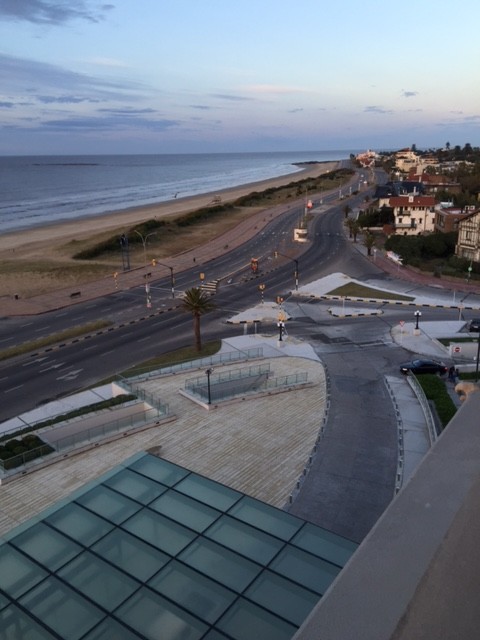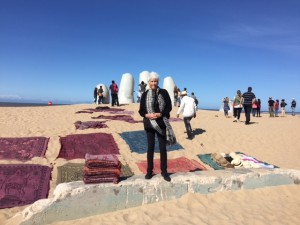If Uruguay was a penny, I’d pick it up and put it in my pocket and never let it go. This small but big hearted country has carved a niche in my soul that will be there forever. It’s the people. Everyone is happy to see you. Even those who might not like you or know you. It’s a nation of “besos” (kisses). Men greet men with kisses. A TV reporter walks into the studio and goes from office to office and kisses everyone as she winds her way to her desk. Attend an afternoon tea, whether shared with plastic plates or elegant ceramic ones, and it is proper to greet every single person (whether you know them or not) with a kiss. There is some rare joy Uruguayans share when they meet and greet someone. And that spirit flies like a golden butterfly through everything that goes on.
Montevideo is a city of about a million and a half in a country of little over three million citizens. All seem to have cars because traffic can be massive jams. Streets cannot hold all the drivers and no one really works together to move on down the road. There are so many illegal motorcycles on the road that the police have collected 4800 of them and store them in a fenced in area along a major street. 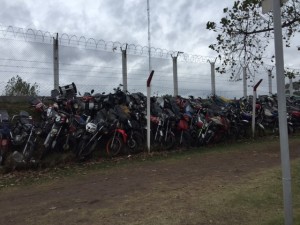 No papers, no motorcycle, like it or not. There seem to be few rules. It is a city that has modern problems – there are 600,000 dogs and the newspaper front page bemoaned what could be done about all the dog poop that messes up the parks and lawns. A favorite scene for me is the dog walkers, which is quite a business here. Holding two leash lines to which many leashes are attached to every kind of dog, the strong walk-masters take the dogs for exercise daily. I’ve never figured out how all the panting, pulling breeds get along without fighting, but they enjoy the outing like pals.There is a secret somewhere, another miracle daily. Montevideo is a city of all ages, extreme elderly to handsome children, but no matter who you are or what you do, you are either an ‘hincha” of Penarol o Nacional, intense enemies on the soccer field. Wear yellow and black, and you are Penarol, which is usually the leader in wins in the famous stadium where Uruguay won the first World Cup ever played in 1930. And all around the city is a “rambla”, a wide sidewalk where citizens walk and run and can embrace the ocean that crawls up the sand almost to the walls when tide is in. On Sundays, families cruise slowly the rambla that runs along the ocean that surrounds about two-thirds of the city, pushing baby buggies while husbands and fathers clasp under one arm a thermos and in the other hand a gourd filled with yerba and boiling water, as he sucks on a silver straw, delighting in the habit of “mate.”
No papers, no motorcycle, like it or not. There seem to be few rules. It is a city that has modern problems – there are 600,000 dogs and the newspaper front page bemoaned what could be done about all the dog poop that messes up the parks and lawns. A favorite scene for me is the dog walkers, which is quite a business here. Holding two leash lines to which many leashes are attached to every kind of dog, the strong walk-masters take the dogs for exercise daily. I’ve never figured out how all the panting, pulling breeds get along without fighting, but they enjoy the outing like pals.There is a secret somewhere, another miracle daily. Montevideo is a city of all ages, extreme elderly to handsome children, but no matter who you are or what you do, you are either an ‘hincha” of Penarol o Nacional, intense enemies on the soccer field. Wear yellow and black, and you are Penarol, which is usually the leader in wins in the famous stadium where Uruguay won the first World Cup ever played in 1930. And all around the city is a “rambla”, a wide sidewalk where citizens walk and run and can embrace the ocean that crawls up the sand almost to the walls when tide is in. On Sundays, families cruise slowly the rambla that runs along the ocean that surrounds about two-thirds of the city, pushing baby buggies while husbands and fathers clasp under one arm a thermos and in the other hand a gourd filled with yerba and boiling water, as he sucks on a silver straw, delighting in the habit of “mate.”
This is a country where the prime industry is the best meat anywhere in the world from grass fed steers; healthy Holstein milk cows are source of tasty cheese and rich milk. Meat is cooked slowly over coals for an “asado” which is a barbecue that includes every part of the steer that exists. It’s a man thing. Men spend hours arranging the coals while cooking everything from brains to filet, bell peppers to chorizos, potatoes to provolone cheese toasted till it begins to drip. And if you are lucky to go to L’Amite in the Mercado de Puerto, you might be able to watch the cook make the best thing I ever put in my mouth – the panqueque de manzana – covered in burnt sugar so it’s crunchy.
Uruguay rarely changes, It takes on new things only when others fade away. Now there are vineyards crossing what once were grazing pastures, and thousands of fast growing Eucalyptus are cut down and chopped into small pieces to be used for paper. Caviar is produced in the interior lakes, and as of late, the government grows and controls marijuana. It kind of gives the place a dominant personality. They are small but they do it their way. The beaches are treasures and lure Argentines and Brazilians in the summertime, and tourist must indulge in a “Chivito” which covers about every kind of thing that can be put in a bun all at once: meat, ham, bacon, egg, lettuce, tomato, pickles, cheeses, sauces, mayonnaise, salsa golf, hot sauces if you wish, and whatever else comes with the kitchen sink. There’s no way to eat a whole one without completely soiling one’s shirt and fingers. But it’s worth it. Uruguay is also home to one of South America’s best contemporary artist, Ignacio Iturria, and an afternoon on his patio with he and his wife discussing the state of art and Uruguay was a highlight. I’ve been a collector of his work for 15 years but never had such an opportunity. At his studio, he gives classes in art and theater to Uruguayan youth with artistic incline.
The first steps I take after leaving the impressive huge airport that looks like a hat a fancy woman would wear to the Derby, is to visit the rambla, step into the sand, and get my feet wet in the salty water. The wind blows a caressing breath and I turn around and look at the giant Carrasco Hotel (a building which has been the center of Carrasco barrio since it was built in 1921 and stood in disarray for the last thirty) which is an icon, and I sigh. “I’m home.” It is a home for me having lived a few blocks up the coast 21 years total. So the memories are excessive and obsessive. 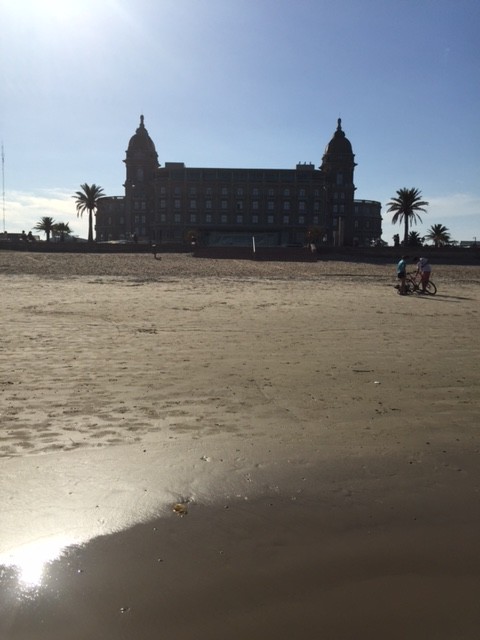 My hangouts were the Anglican Cathedral on the Rambla in Ciudad Vieja, where I was ordained – still without heat but with organ and stained glass windows which are treasures beyond the norm – and worked a soup kitchen there in its bowels for the homeless. More important was ministry in the prisons: Com Car which now houses 3800 prisoners (it held about 2000 bodies when I worked there in 2002) and Libertad, further up the river for the worst of criminals. There’s also the wonderful world of garden club where miracles happen in the hands of expert designers and gardeners – there are about 40 garden clubs in tiny Uruguay and competition at flower shows is stiff, but always, for the judges, there is a tea after the work is done, a tea that would fit right into any British High Tea at a swish hotel. Curious always is the hour and a half drive to Punta del Este, driving along the edge of the sea where exercise equipment is installed permanently and there is the famous sculpture of a a hand, its fingers rising out of the sand. it’s a photo opp. On May 1st, Labor Day, a true holiday when everything shuts down, I was entertained by the Punta garden club leaders at a wonderful meal on a beautiful chakra of roses, and friends, as a cool breeze made music with the birds in shrubs and trees, and there was a peace that passes all understanding.
My hangouts were the Anglican Cathedral on the Rambla in Ciudad Vieja, where I was ordained – still without heat but with organ and stained glass windows which are treasures beyond the norm – and worked a soup kitchen there in its bowels for the homeless. More important was ministry in the prisons: Com Car which now houses 3800 prisoners (it held about 2000 bodies when I worked there in 2002) and Libertad, further up the river for the worst of criminals. There’s also the wonderful world of garden club where miracles happen in the hands of expert designers and gardeners – there are about 40 garden clubs in tiny Uruguay and competition at flower shows is stiff, but always, for the judges, there is a tea after the work is done, a tea that would fit right into any British High Tea at a swish hotel. Curious always is the hour and a half drive to Punta del Este, driving along the edge of the sea where exercise equipment is installed permanently and there is the famous sculpture of a a hand, its fingers rising out of the sand. it’s a photo opp. On May 1st, Labor Day, a true holiday when everything shuts down, I was entertained by the Punta garden club leaders at a wonderful meal on a beautiful chakra of roses, and friends, as a cool breeze made music with the birds in shrubs and trees, and there was a peace that passes all understanding.
Horses are a major source of entertainment – from the endurance races to the golden Russian Akateks, to summertime polo in Jose Ignacio, where the world’s number one player today, Pelon Stirling, arose and now plays in Wellington, Fla. in winters. Then there is Marones – once a falling apart, dead race track in 2002 when I left, but purchased by three investors who turned it into a showplace that today can compete with the best of them. I was able to visit the stud (Stables) my husband Sergio and I owned in the ‘90ties, where our former trainer still creates winners and keeps the spirit of La Felicidad alive. Marones itself (a poor barrio but in a bar one can get coffee and the best “media lunas” anywhere (croissants made with crisco, not butter, served with ham and cheese and homemade butter) is full of life and routine, finally paying healthy prizes to winners while there is news that a turf or grass track is to be added soon. There are races every Saturday and Sunday all year long, with the most coveted victories on January 6 each year. I remember the great day when our superstar Centaurus won, among many, a stakes race by 56 lengths. Those moments never fade. On this journey, the first “peon” or groom we ever had greeted me with a kiss, he who had been responsible for Profeta, the first race horse we ever owned.
I was able to visit the British Hospital, where I had been chaplain for many years, accompanied those with cancer, prayed for those ready to die, visited the old folks home, and helped the hospital start a computer system. There the director had donate a small empty space for me to make a chapel so we could do “misas” there once week for those in the Winston Churchill Home for the Aged. Ironically, the space had once been the office of Dr. Tabarez Vasquez, a cancer doctor, who is a past and the current president of Uruguay. Holy places stay strong. Since I was left in 2002, the hospital has added an elegant glass wing, and another branch in Carrasco barrio. In Uruguay, a person has a membership in a hospital plan and receives all that’s needed at that hospital. There are no insurance policies like in US. Not far away stands the AIDS hospital where my fellow Deacon Marta Tamayo and I started visits to those sick and dying in the 1990s. But It was at the British Hospital that I got to know Melba, an OBGYN nurse, whose teenage son, with great potential in the world of soccer, was attacked by a rare cancer, and I was able to accompany them through the nightmare until he died. But not long after his loss, Melba asked if Sergio and I could find an old bus as she and her husband Mario wanted to start a ministry in the poorest of barrios for little children to receive milk and a snack in the afternoons. Sergio found the old blue bus and it was hauled to where Melba wanted it to be. She set up her afternoon feed to little ones. During my recent visit, a vice president of INAU who had once assisted in the social service of the Anglican Church, said I must go see El Cayote. I could not recall who or what El Cayote was, but was eager to visit whatever it was. As we approached, there were Melba and Mario standing before what has become a number of school rooms, a social center and church for many children in one of the most difficult and dangerous barrios in town. It was now concrete building painted in bright colors with colorful rooms and a second story under construction, all to the honor of their deceased son, who was knick-named El Cayote in his soccer days. What joy to see how a simple seed planted could bring so much goodness and hope to a tough place, all through the labor and love of this Baptist couple.
And then there was the trip to Santiago Vazquez or Com-Car, a huge prison complex once home to six large cell blocks, and now to nine plus one in the back painted white with curls of wire all over it, which is sort of an isolation place, bright white on the outside, with no windows, for the most brutal of prisoners. The new Canadian Anglican Bishop who had not been there yet, accompanied me as did a long time police friend who is now working in the Sub Direccion Nacional Administrativa de Carceles Area Logistica. On a perfect fall day, he met us at the prison entrance, through which I had passed so many times, in the old days with sacks of homemade chocolate chip cookies for the guards who were required to search me – but now it was much more involved and complicated with a new entrance and all sorts of scanning machines, filled today with mothers and wives and visitors. Their arms were filled with plastic bags of food, clothing, bedding and whatever would pass the inspections so as to make life livable for their men.
We walked the walk I remember so well down to Modulo 13 (now called 6) , and passed a vegetable garden still producing herbs and veggies that had been launched under the hand of Warden Cardoso, now retired but with whom I had worked closely. There were no more sheep, which used to wander around the green areas, but there are plenty of stray dogs instead. We stopped by the current warden’s office and were given a warm welcome and then a chance to tour all the new projects which provide work and activities for many of the prisoners who want to achieve something and prepare for the world outside, not only construction and industrial materials, like concrete blocks, and wooden slats, but computer workshops and fiberglass kayaks and even music DVDs and artistic and computer programs. I even met some guys still there since the days we had created Theater Experimental Audrey Taylor, with which we tossed the spirits of prisoners into a play, El Hierro y La Muerte, and made a noise that hasn’t been experienced since – 24 dangerous prisoners performing in the public theater!! Often accused of inhuman activities, the over-crowding in Com-Car has been alleviated by the addition of new cell blocks, with a special unit for the most violent and ill-behaved prisoners created with no windows, a place not a country club atmosphere but where criminals can meditate on their behaviors and crimes for a couple of weeks in solitary.
Most rewarding to me was a stop at the Chapel which I had funded so there would be a place for prisoners and the guards to worship and meditate in this large prison compound. It was clean and beautiful, with painted decorations and flowering plants on the pathway leading to it. It filled me with great hope and gratitude, for it had been put together by the prisoners themselves a few years back. Another seed planted and blooming.
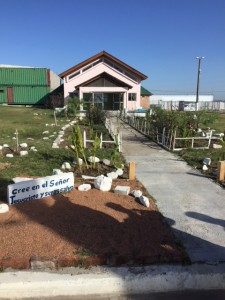 One challenge on this trip was to have an interview with the now ex-presidente Jose Mujica, who lived all during his presidency on his own chakra (small farm) instead of the fancy presidential mansion, and on which he had put together a number of containers to became classrooms for children in the area so they received the best of education, right at his front door. We rose before dawn for a good hour drive to his home, when I was supposed to have the privilege, as it had been sanctioned by his wife Lucia Tupamaro, (running for city Mayor), and his secretary. It was all very informal as we waited in the brisk morning air until it was 8 a.m. and watched the children and professors arrive at the classrooms in the barn area. When the security guard, a thermos and mate in his hands, called the house, Mujica was doing a radio program, and we were told, no time for the interview, as there was so much to do before the upcoming urban election.
One challenge on this trip was to have an interview with the now ex-presidente Jose Mujica, who lived all during his presidency on his own chakra (small farm) instead of the fancy presidential mansion, and on which he had put together a number of containers to became classrooms for children in the area so they received the best of education, right at his front door. We rose before dawn for a good hour drive to his home, when I was supposed to have the privilege, as it had been sanctioned by his wife Lucia Tupamaro, (running for city Mayor), and his secretary. It was all very informal as we waited in the brisk morning air until it was 8 a.m. and watched the children and professors arrive at the classrooms in the barn area. When the security guard, a thermos and mate in his hands, called the house, Mujica was doing a radio program, and we were told, no time for the interview, as there was so much to do before the upcoming urban election.
Jose Mujica is one of the great characters in South American history, a man humble and focused on making life better for the poor, much in the manner of the new Catholic Pope from Argentina, whom he was to meet a few days after my visit. One third of his salary he kept for his expenses, but the rest went to build homes for the poor and help small businesses. He refused a police escort, drove himself in his old Volkswagon Beetle, and avoided any of the falderal that normally accompanies the presidential role. He also decided the government would grow and sell marijuana, but no one else could legally. During his reign, as well, vineyards have exploded all over the country and the cattle business thrives. But many of the old Uruguayan gentry never forget that Mujica was a Tupamaro, a Cuban-inspired armed political group, in the tense days when the military was in charge and attempting to eliminate Latin communism of a sort. In the seventies, President Mujica was young, vibrant, an urban guerrilla fighter, shot six times, and thrown into prison for thirteen years, escaping a couple of times, during the military dictatorship of the ‘70ties and ‘80ties. I arrived in Uruguay 1984 when the military restored the constitutional democracy and through an act of amnesty, Mujica was freed from his tortuous time in prison. From then on he was always a part of the political scene. He had survived through a difficult time in South America when everyone was suspect and no one to be trusted as so many disappeared into nothingness. But Uruguay has spunk and heart. Long live this great country.

